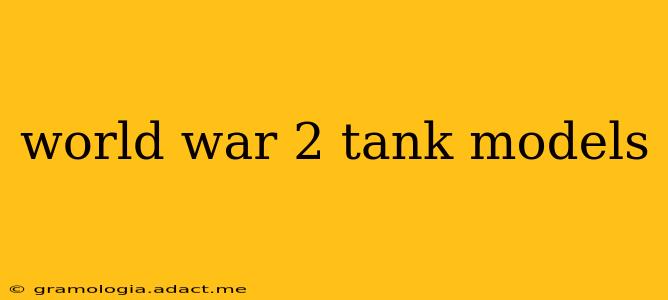World War II witnessed an unprecedented arms race, with tank design and production reaching feverish levels. From the iconic Panzer IV to the formidable Sherman, countless tank models shaped the battles and ultimately the outcome of the war. This guide delves into some of the most significant and influential tank models from both the Axis and Allied powers, exploring their design, strengths, weaknesses, and impact on the conflict.
What were the most common tanks used in World War 2?
Several tanks dominated the battlefields of WWII, each with its unique characteristics and roles. On the Axis side, the German Panzer III and Panzer IV were workhorses, seeing service throughout the war and undergoing constant upgrades. The Panzer III, initially designed as an anti-tank vehicle, evolved to a more general-purpose role, while the Panzer IV, with its high-velocity 7.5 cm gun, became a crucial support tank. The Tiger I and Tiger II represented the pinnacle of German heavy tank technology, boasting immense firepower but suffering from mechanical unreliability and limited production numbers. The Japanese Type 97 Chi-Ha medium tank, while less technologically advanced than its Western counterparts, played a significant role in the Pacific Theater.
The Allied forces relied on various tanks, with the American M4 Sherman being arguably the most widely produced and used. Its reliability, ease of maintenance, and relatively low production cost made it a backbone of Allied armored forces. The Soviet Union's T-34, with its sloped armor and powerful gun, proved a formidable opponent, significantly impacting the Eastern Front. The British Churchill tank, known for its heavy armor, was effective in defensive roles and close-quarters combat.
What were the strengths and weaknesses of the German Tiger tank?
The Tiger I heavy tank, a symbol of German might, possessed considerable strengths, notably its incredibly powerful 88 mm gun, capable of destroying most Allied tanks at long range. Its thick armor provided excellent protection against enemy fire. However, its weaknesses were equally significant. Its complex mechanics proved unreliable, leading to frequent breakdowns and requiring specialized maintenance. Its high fuel consumption and limited production numbers significantly hampered its deployment and strategic impact. Its weight also limited its mobility across various terrains. The Tiger II, while even more heavily armored and armed, suffered even more acutely from these shortcomings.
What was the most effective tank in World War 2?
Determining the single "most effective" tank in WWII is a complex question, as effectiveness depends on several factors, including the specific context of the battle, the enemy it faced, and the overall strategic objectives. The T-34's sloped armor and powerful gun made it a formidable opponent on the Eastern Front, its design significantly influencing post-war tank development. The Sherman's widespread deployment and reliability made it a crucial component of Allied success. The Tiger's firepower was unmatched by many of its contemporaries, but its limitations ultimately restricted its effectiveness. The answer often depends on the criteria used for assessment, making a definitive answer difficult.
What were some other notable World War 2 tanks?
Beyond the aforementioned tanks, numerous other models played crucial roles. The British Cromwell tank, a medium tank known for its speed and maneuverability, proved valuable in mobile warfare. The American M26 Pershing, introduced late in the war, boasted superior firepower and armor to the Sherman but arrived too late to significantly impact the overall conflict. The Japanese Type 4 Ha-To, a light tank, was deployed in the Pacific Theater, though its limitations were evident compared to Allied tanks. Numerous other designs from various nations contributed to the overall complexity of armored warfare during the war.
What makes a tank effective in warfare?
The effectiveness of a tank is determined by a combination of factors. Its firepower, determined by the caliber and effectiveness of its main gun, is paramount. Armor protection, providing survivability against enemy fire, is also crucial. Mobility, encompassing speed, maneuverability, and reliability, dictates its tactical capabilities. Finally, the logistical considerations, such as ease of maintenance, fuel consumption, and production costs, play a significant role in determining its overall effectiveness in the context of a broader war effort.
This overview touches upon some of the key tank models of World War II. Further research into specific designs and battles will reveal the intricate interplay of technological advancement, tactical doctrine, and logistical realities that shaped the course of the conflict.
